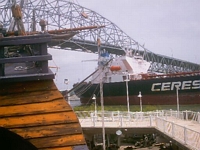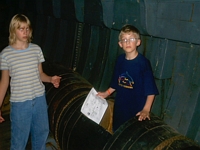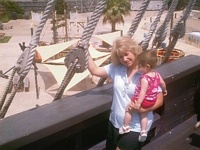Corpus Christi
Museum of Science and History
Corpus Christi, Texas
article by Joel
Fleischer
"In 1492 Columbus
sailed the ocean blue..."
Don't ask me how the rest of
the poem goes, but that little
piece of poetry has run through my head since first grade.
Don't bother trying to tell me that Columbus didn't
discover America or that Leif Ericson came first. So what?
Leif and his Viking buddies hopscotched across the Atlantic
via Iceland and Greenland. Columbus took three small ships
and sailed straight across the Atlantic, from the Canary
Islands to the Bahamas without a break. Sure, he didn't
know where he was (he thouhgt he was in Asia) but it took
guts to undertake such a voyage.
(click the images
below for larger versions) |
| 
The Pinta
|

The Santa Maria |
One's appreciation for this daring
exploit is increased when one sees the "ships" that Columbus
boarded with 150 men. Such insight is easy to come by at the
Corpus Christi Museum of Science and Natural History.
Since 1993 the Pinta and the Santa Maria have been on display.
Visitors can board the ships and tour the cargo hold and Captain's
cabin.
The ships were built in the space
of five years by Spain to commemorate the 500th anniversary
of Christopher Columbus' voyages to the New World at a cost
of $6.5 million, using many of the same materials used by 15th
century shipbuilders. The pine and oak are from the same forests
of Galicia and the Pyrenees, the nails are forged by hand, the
caulking is hemp, and the sails are made of linen, the closest
natural fiber to the hemp canvas used in the 1400s.
When the ships were completed,
they toured the Mediterranean and Atlantic ports of Europe in
1990 and 1991, followed by a 1992 tour of 18 United States ports,
before arriving in Corpus Christi, Texas in 1993. The Pinta
and Santa Maria were damaged in an accident in the Corpus Christi
harbor, and were drydocked for repairs at the Corpus Christi
Museum of Science and History. The Nina, moored at the Corpus
Christi Marina, is not open to the public, but may be viewed
on your way to dinner at Joe's Crab Shack on the T-heads.

The Old World meets the New World
|

Alex and Leah in the hold of the Pinta.
|
 The Captain's Cabin on the Santa
Maria.
The Captain's Cabin on the Santa
Maria. |
The Captain's Cabin is surprisingly
plush, especially when you consider that the rest of the crew
had to take turns sleeping in the shelter of the poop deck.
 |
 |
Looking aft on the Santa
Maria.
The Captain's Cabin is on the top |

The Windlass
The poop deck also sheltered
the windlass, a large winch that performed a variety of tasks
on the ship, including winching cargo out of the hold as well
as raising the sails and the anchor.

The wee-lass and her mother
examine the rigging on the Santa Maria
|

The tiller
|
The enormous rudder was directed
by means of a very long tiller. The crew would move the tiller
with a block and tackle.

The Rudder on the Santa Maria |

Looking out the rudder hole.
Standing headroom
(if you're only four feet tall) |
After you've toured the ships,
the ramp leads visitors to an interactive display. Visitors
can experiment with block and tackle systems, navigation tools
and other Fifteenth Century sailing equipment.
 |
 |
A replica of the Columbus
launch |
The Columbus ships alone made
the $10 entry fee worth every penny. Make sure you stop at the
tourism building outside the Museum and ask them for coupons
to the harbor attractions. They'll give you coupons for money
off for the entry fees for the Science Museum, the Aquarium,
and the Lexington aircraft carrier.
Joel "No Bucks" Fleischer
Marquette, Michigan

